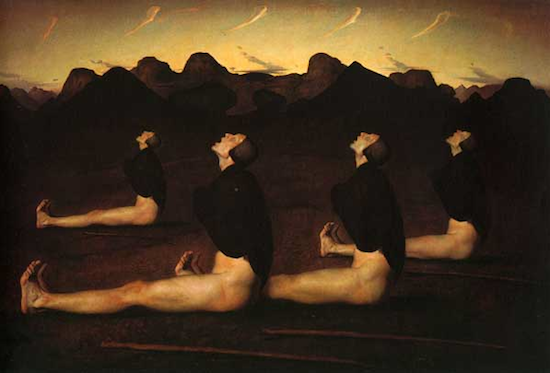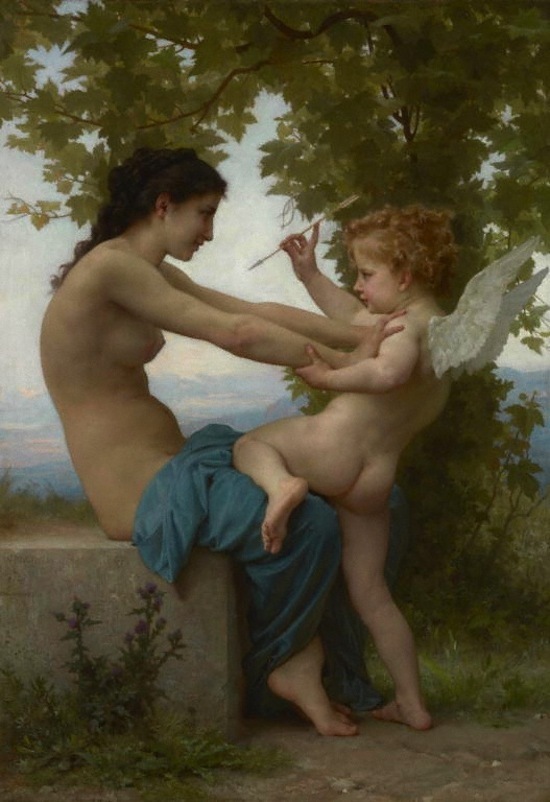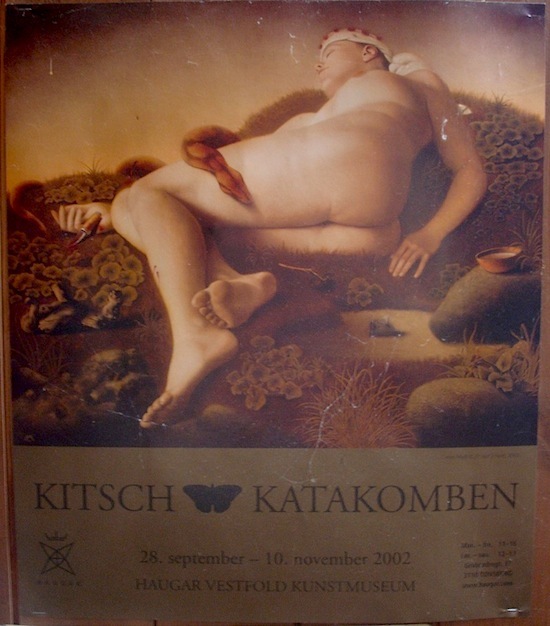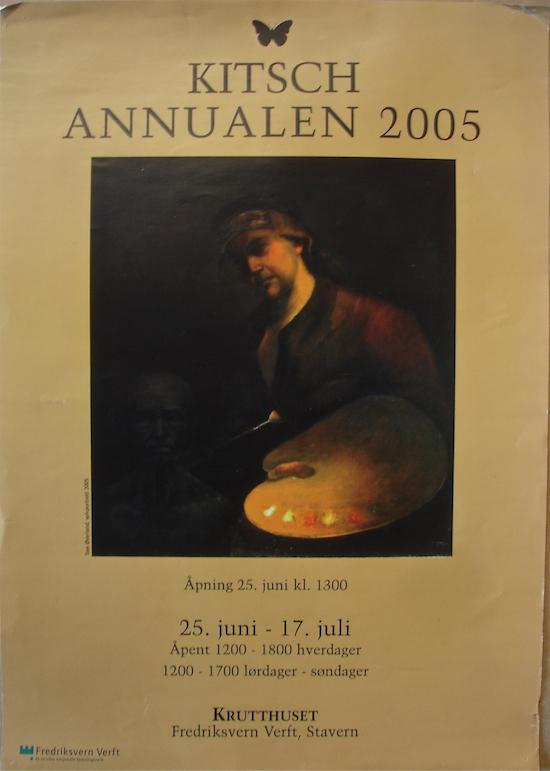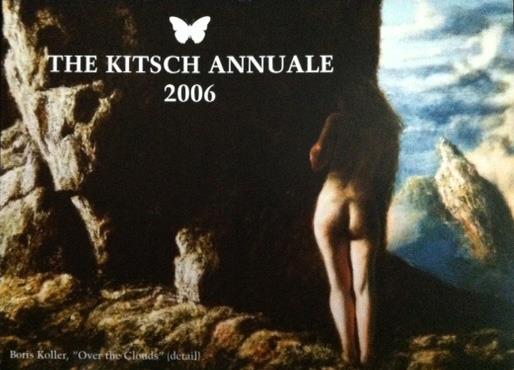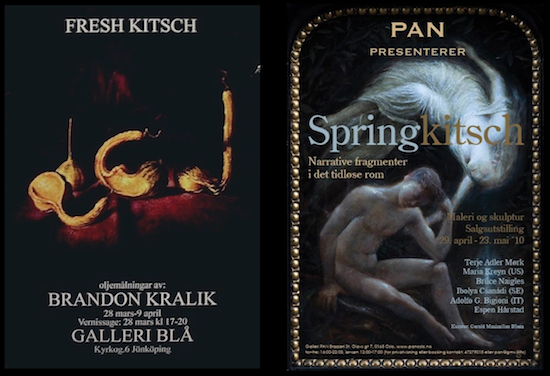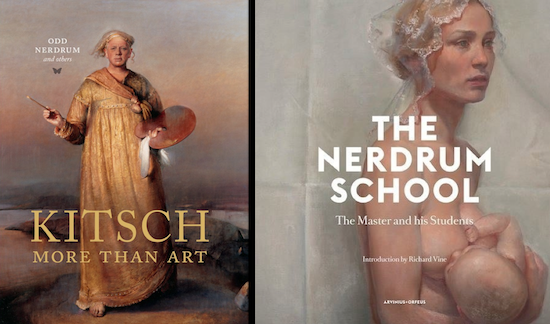"There is more to be won from earnestness than from irony." - Odd Nerdrum
Kitsch is not something you have to decide anything about. The work has been done for you. It is here for you to look at, to learn from and to enjoy. While people debated semantics, it happened right before your eyes. Do you feel that you may be missing something? You very well may be.
Dawn, by Odd Nerdrum,1990
The Kitsch Movement began 15 years ago when Odd Nerdrum declared himself a Kitsch Painter. This occurred at the opening of the large 1998 retrospective exhibit of his paintings at the Astrup Fearnley Museum in Oslo. It was at this point that Nerdrum admitted that those who had been calling his paintings kitsch were correct in doing so, and he apologized for masquerading as an artist. Nerdrum had not been the only painter to be branded with the kitsch label, it had been applied to many of us, but he was the first one to accept the moniker and wear it with pride.
Michael Gormley, then editor of American Artist Magazine, eloquently pointed out in his introduction of Nerdrum, who spoke in New York at Weekend with the Masters in 2011, that Nerdrum has done for the word Kitsch what the LGBT did for the word Queer. Liberated it.
According to the Kitsch Movement Wikipedia page, Kitsch painters embrace it as a positive term: not in opposition to art, but as its own independent superstructure. Thus, Kitsch painters assert that Kitsch is not an art movement, but a philosophical movement: a superstructure of values and philosophy which are separate from art.
Nerdrum claims that, "Kitsch signified the antithesis of modern art. Kitsch became the unified concept for all that wasn't intellectual or new, for all that was conceived as brown, old-fashioned, sentimental, melodramatic and pathetic." He quoted the philosopher Hermann Broch (1886 - 1951), a leading proponent of Modernism in his time, who had some things to say about it like, "Kitsch is the Anti-Christ, stagnation and death". Wow! That is some strong terminology for pretty pictures. Broch wrote of the differences between Art and Kitsch but also had the sense to admit that there are geniuses within kitsch, like Wagner and Tchaikovsky. Ilya Repin could be said to be a genius of kitsch in the painting realm. Zorn bore the label and is now regarded one of Sweden's great masters by many. Bouguereau is almost certainly the painter whose work is most often associated with the kitsch label but clearly, at least to some circles, he is brilliant. For the past 100 years, the term has applied to Victorian paintings and reproductions of them, to propaganda posters, even to figurative painting in general. Andrew Wyeth, one of America's greatest painters was branded as kitsch. But, wait a minute, what is this? I like this kind of thing!
A young Girl Defending Herself Against Eros by William-Adolphe Bouguereau, 1880. Digital image courtesy of the Getty's Open Content Program.
Nerdrum pointed out in his book, On Kitsch, which was first published in 2000, that "Kitsch is about the eternal human questions, whatever its form, about what we call the human." He defended the gypsy girl and the boy with the tear, classic examples of kitsch, because they appeal to our senses, to our human nature. Nerdrum points to Hope by Frederic Watts as a classic Kitsch picture and it was featured on the cover of the book which he co-authored with several other writers. Essays by Jan Ove-Tuv and Jan-Erik Ebbestad Hansen, Dag Solhjell, Sindre Mekjan, and Nerdrum himself make sense of the reasons why Nerdrum re-appropriated the word kitsch. Unfortunately the book is now out of print, but you might be able to get one from Amazon for about $300, if you hurry. It cost half that much last spring. The information is important and valuable.
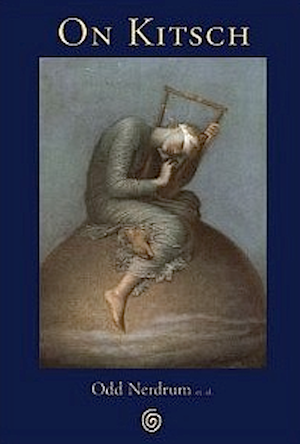
On Kitsch, by Odd Nerdrum, Jan-Ove Tuv and others, 2000
As soon as I first came across these ideas they made sense, although, I promise you, there have been questions and many long fireside discussions trying to work out the grey areas of the composition that we call Kitsch. Extremely interesting discussions indeed! For those of you who have been present, you know what I am talking about. For the rest of you, you are missing something special.
A truly fantastic group of painters who assembled together at the turn of the century, in the early days of what has been called the Kitsch Movement. Nannehttp://nannenyander.se/ Nyander, Jan-Ove Tuv, Helene Knoop, Monika Helgesen, Hege Elizabeth Haugen, and Carlos Madrid were some of the painters who were working with Nerdrum when I first arrived in the summer of 2000. In the summer of 2002, two exhibitions were held featuring the paintings of this group which also included Stefan Boulter, Kjetil Jul, Irena Jovic, Brad Silverstein and myself. Speeches were given by Nerdrum, and Tuv, and together they addressed the issue of Kitsch. During this time Odd and Jan-Ove were also traveling to Pennsylvania and New York and holding talks about the philosophy of Kitsch. Nerdrum is good at holding court, so to speak, and his vast collection of knowledge on this subject is astonishing.
Poster for the Kitsch Catacomb exhibition, 2002
In the fall of 2002 the first museum exhibition under the Kitsch title was held at the Haugar Vestfold Kunst Museum in Tønsberg, Norway, and was titled Kitsch Katacomben. The Kitsch Catacomb. At several of those early fireside chats, I remember the group discussing how it was important to have Kitsch exhibitions outside of Norway as well, exhibitions with and without Nerdrum, that would help the movement expand and bring attention to Kitsch for what it is, which is as much a lifestyle as a movement, more philosophy than art. And that is exactly what has happened. Kitsch continues. Patiently smiling out at us from the shadows.
Rather than being another art movement, Kitsch stands independent, with its own criteria for greatness, which are different from those of Art. Criteria which include talent, skill, sentimentality, and the ability to tell a story with beautiful passages of light, to convey emotion. Composition, beauty and the longing for the eternal, timeless state, all play factors in the Kitsch paradigm. But even without the philosophy one sees the painting, one hears the orchestra and it is immediately felt and comprehended on an emotional rather than an intellectual level. Odd says that "Kitsch stands by even the most uneducated audiences".
"The task of kitsch", says Nerdrum, "is to create a seriousness in life, at its best so sublime it will bring the laughter to a quiet. Kitsch seeks life and therefore seeks the individual, in contradiction to art's irony and dispassion." The differences between kitsch and art was brought up by Broch and was also written about by Clement Greenberg in his famous essay The Avante Garde and Kitsch and these arguments, according to Nerdrum, can be traced back to Hegel and Kant, who separated and raised the importance of the idea up above that of handcraft. Since the publication of Nerdrum's book, other writers have also hit upon the idea of this same seperation. Most notably, Larry Shiner in The Invention of Art and more recently, Patrick Doorly in his book The Truth About Art.
So that is how the Kitsch Movement began, which simply resonated with my experience when I first heard it. I understood the Kitsch lifestyle intuitively. I had previously came across many of the pieces of this puzzle, which were scattered here and there throughout the 20th century, but Odd took the story farther back, before Greenberg, before the Impressionists, back to the German philosophers and sewed it all together with a thread of genius, with clues as to what happened, and what we might do about reintroducing beauty and quality into our culture.
There were other painters before my time at Nerdrum's studio, and others who have come since that make up the Nerdrum School and I have had the pleasure to meet many of them. The painters who were there in the early days of this Kitsch declaration, this movement, this way of life, were there at the right time and became part of a splash that we continue to see the ripple effects from.
Stefan Boulter held a solo show, simply titled Kitsch when he returned to Iceland in 2003 and I remember Odd admiring the boldness of it. I recall listening along with a packed house as Nanne Nyander gave a speech about Kitsch at Jönköpings Lans Museum where a series of her Kitsch paintings were exhibited in 2002. Nanne and I held a Kitsch exhibition together in 2004 and my first solo exhibition was held in Jönköping, Sweden in 2008 and was titled Fresh Kitsch.
Poster for the Kitsch Annual, 2005. Painting by Tom Overland
Popster for the Kitsch Annual, 2006, painting by Boris Koller
The Kitsch Annual began in Norway in 2004 and was held there in 2005 and 2006 before it expanded into the Kitsch Biennale, which has since been held in Germany (2008), and in Venice (2010). Kitsch exhibitions were held in Sweden in 2009 and Galleri Pan of Oslo held it's first of several Kitsch exhibitions that year as well, titled Fall Kitsch.
Kitsch Posters from Brandon Kralik's Fresh Kitsch exhibition, 2008 in Sweden and from Galleri Pan's Spring Kitsch exhibition in Norway, 2010.
The group that has gathered around Kitsch and the Nerdrum School is one of brilliance. Little by little the ideas that define the Kitsch Movement were spread by the efforts of these early Kitsch painters and now Kitsch is finding support in the United States, in China, and around the world. A book of collected work from the Nerdrum School will be published later this fall.
The Kitsch group has expanded to include painters such as Richard T. Scott whose contributions have led to the spread of the Kitsch philosophy in the US, Maria Kreyn, whose interview with Nerdrum appears in the book, Kitsch More than Art (2011), and Roberto Ferri, who exhibited at the Biennale del Kitch 2010, in Venice, Italy. In addition to the many painters who have not been mentioned, there are also many musicians, writers and actors who play roles in the movement of Kitsch.
Odd has written several plays over these years and the first one, performed in 2000 cast Kristopher Hivju in the role of Nerdrum, who, in the play, has a conversation with Edvard Munch. You may know Hivju for his portrayal of Tormund Giantsbane on Game of Thrones. Back in the early days of Kitsch he was a regular carachter around the Nerdrum farm. The author of Shantaram, Gregory David Roberts has appeared with Nerdrum on television in Sweden and has written in support of Nerdrum and the importance of his work, as has Dag Solhjell, Richard Vine, Allison Malifronte, and a growing list of others. The composer, Martin Romberg, has composed music to accompany Nerdrum's work and painters interested in learning from the master continue to seek out his paintings, his books and his company. One cannot be sure who will appear on any given visit to Kitsch headquarters, but one can advance with the certainty that they will be interesting and gifted individuals and therefore important and valuable.
Kitsch More Than Art by Odd Nerdrum, 2011 and The Nerdrum School, which is scheduled to be released in late 2013.
Odd works harder than any other painter I know. He has been doing it for longer than most of us have been alive and I know how he likes to be at home in his studio, with his family and friends. When it was announced last week that Odd Nerdrum will debate with English philosopher Roger Scruton we were given a rare opportunity to hear Nerdrum speak of his philosophy in person. TRAC2014 will be held next March in Ventura, California and is being organized by Michael Pearce who will moderate the conversation between Scruton and Nerdrum. As hinted at on the Nerdrum Museum's website, beauty and Kitsch will likely be served. Kitsch is still here, still wafting into the air like the age old pleasure that arises from the scent of fresh baked bread!
As you can see, there need be no discussion about whether to call it Kitsch or not. It already is. The painters, musicians, writers and actors whose paths have crossed Nerdrums over the decades form the kind of group that most creative people dream of becoming a part of. A group that works hard, creates exceptional work, and exhibits together around Scandinavia, Paris, Italy, and in North America. It exists here and now. While people are debating about the re-appropriation of the word, whether or not it should or shouldn't be, Kitsch keeps smiling at you with it's honest and trusting face.
Kitsch is what it is and it is beautiful, important, and valuable, with or without permission.

